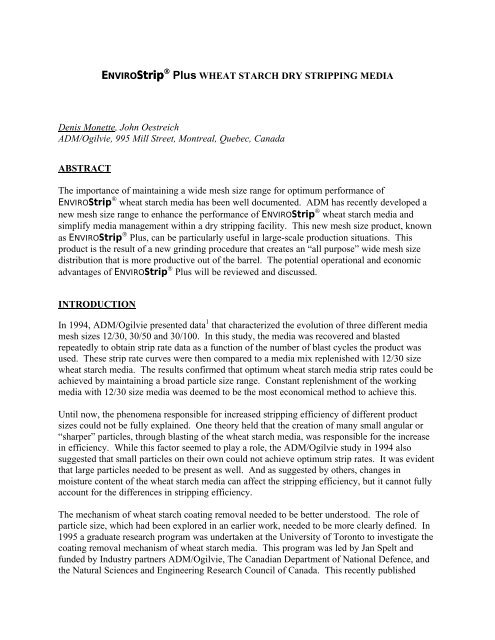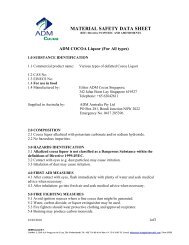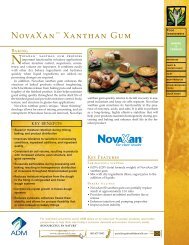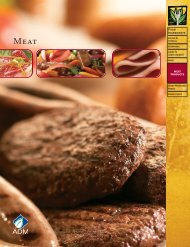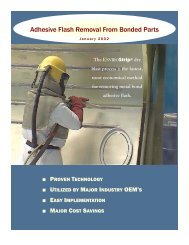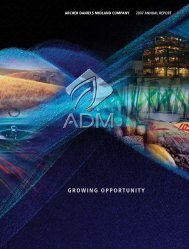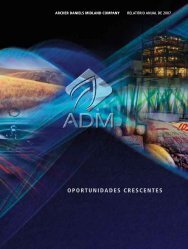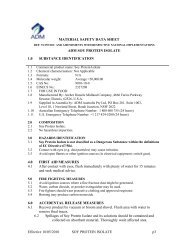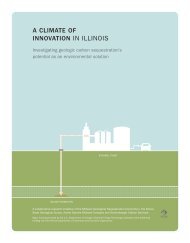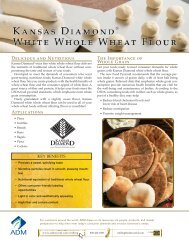EnviroStrip Plus Stripping Technology - ADM
EnviroStrip Plus Stripping Technology - ADM
EnviroStrip Plus Stripping Technology - ADM
- No tags were found...
You also want an ePaper? Increase the reach of your titles
YUMPU automatically turns print PDFs into web optimized ePapers that Google loves.
ENVIROStrip<br />
® <strong>Plus</strong> WHEAT STARCH DRY STRIPPING MEDIA<br />
Denis Monette, John Oestreich<br />
<strong>ADM</strong>/Ogilvie, 995 Mill Street, Montreal, Quebec, Canada<br />
ABSTRACT<br />
The importance of maintaining a wide mesh size range for optimum performance of<br />
ENVIROStrip ® wheat starch media has been well documented. <strong>ADM</strong> has recently developed a<br />
new mesh size range to enhance the performance of ENVIROStrip ® wheat starch media and<br />
simplify media management within a dry stripping facility. This new mesh size product, known<br />
as ENVIROStrip ® <strong>Plus</strong>, can be particularly useful in large-scale production situations. This<br />
product is the result of a new grinding procedure that creates an “all purpose” wide mesh size<br />
distribution that is more productive out of the barrel. The potential operational and economic<br />
advantages of ENVIROStrip ® <strong>Plus</strong> will be reviewed and discussed.<br />
INTRODUCTION<br />
In 1994, <strong>ADM</strong>/Ogilvie presented data 1 that characterized the evolution of three different media<br />
mesh sizes 12/30, 30/50 and 30/100. In this study, the media was recovered and blasted<br />
repeatedly to obtain strip rate data as a function of the number of blast cycles the product was<br />
used. These strip rate curves were then compared to a media mix replenished with 12/30 size<br />
wheat starch media. The results confirmed that optimum wheat starch media strip rates could be<br />
achieved by maintaining a broad particle size range. Constant replenishment of the working<br />
media with 12/30 size media was deemed to be the most economical method to achieve this.<br />
Until now, the phenomena responsible for increased stripping efficiency of different product<br />
sizes could not be fully explained. One theory held that the creation of many small angular or<br />
“sharper” particles, through blasting of the wheat starch media, was responsible for the increase<br />
in efficiency. While this factor seemed to play a role, the <strong>ADM</strong>/Ogilvie study in 1994 also<br />
suggested that small particles on their own could not achieve optimum strip rates. It was evident<br />
that large particles needed to be present as well. And as suggested by others, changes in<br />
moisture content of the wheat starch media can affect the stripping efficiency, but it cannot fully<br />
account for the differences in stripping efficiency.<br />
The mechanism of wheat starch coating removal needed to be better understood. The role of<br />
particle size, which had been explored in an earlier work, needed to be more clearly defined. In<br />
1995 a graduate research program was undertaken at the University of Toronto to investigate the<br />
coating removal mechanism of wheat starch media. This program was led by Jan Spelt and<br />
funded by Industry partners <strong>ADM</strong>/Ogilvie, The Canadian Department of National Defence, and<br />
the Natural Sciences and Engineering Research Council of Canada. This recently published
work 2 proposes new insights into the phenomena behind wheat starch coating removal. This<br />
work also helps to explain why the new ENVIROStrip ® <strong>Plus</strong> wheat starch media offers improved<br />
coating removal efficiency.<br />
The objective of this paper is to compare the basic performance of ENVIROStrip ® <strong>Plus</strong> to 12/30<br />
and 30/100 size media, and to elaborate on some aspects of the mechanism by which wheat<br />
starch media removes coatings.<br />
DISCUSSION<br />
EXPERIMENTAL PROCEDURES<br />
1. Blasting Test Equipment<br />
Testing was conducted in a modified Pauli Systems RAM 31 hand cabinet using a 3 / 8 -inch<br />
nozzle. In all tests conducted, blast pressures were continuously monitored at the pressure pot by<br />
a digital pressure gauge. Nozzle pressures were verified at the beginning of every blast cycle by<br />
two different needle gauges.<br />
2. Product Breakdown/Consumption Rates<br />
For media breakdown tests, thirty-pound batch quantities of ENVIROStrip ® 12/30 and <strong>Plus</strong> mesh<br />
sizes were evaluated in the hand-cabinet. A 0.250-inch thick plate of 7075 T-6 aluminum was<br />
used as the blast target. A six-blast cycle test was performed to determine the amount of media<br />
waste that would be produced, when tested under the parameters listed below.<br />
ENVIROStrip<br />
® Wheat Starch Media Parameters<br />
Nozzle type<br />
Nozzle pressure<br />
Media flow rate<br />
Nozzle angle<br />
Nozzle distance<br />
3 / 8 -inch Double Venturi<br />
35 ± 1 psi<br />
8 - 9 lb/minute<br />
45 degrees<br />
6 inches<br />
3. Coated Test Panels<br />
An aerospace contractor, in accordance with USAF guidelines, prepared the coated test panels.<br />
The substrate material was 0.032-inch 2024 T-3 clad aluminum. The coating system applied was<br />
Mil-P-23377 epoxy polyamide primer followed by a Mil-C-83286 polyurethane top coat. All<br />
panels were artificially aged using a 7-day room temperature cure followed by a 210°F oven<br />
bake for 96 hours. All panels met or exceeded coating hardness (4H) and dry adhesion (4B)<br />
properties.<br />
The coating thickness of the panels was measured with an Elcometer instrument. Coating<br />
thickness values ranged from 5.5 – 7.0 mils, which is higher than USAF specifications.<br />
2
4. Strip Rate Tests<br />
Each ENVIROStrip ® mesh size was tested for stripping efficiency on the coated test panels<br />
described above. The same blast parameters used during the breakdown tests were employed.<br />
The hand-cabinet cyclone was adjusted to remove media between 100 and 120 mesh in size.<br />
DISCUSSION OF RESULTS<br />
1. Product Breakdown/Consumption Rates<br />
Using the parameters above, the breakdown rate of ENVIROStrip ® <strong>Plus</strong> was compared to<br />
ENVIROStrip ® 12/30 size media. After 6 cycles, both the working media and dust lost to the<br />
cyclone were recovered and weighed. A mesh size analysis was performed on the remaining<br />
media and the total waste generated (i.e. media
Table 1. Average Particle Diameter of Different ENVIROStrip<br />
® Products.<br />
ENVIROStrip<br />
®<br />
Mesh Size<br />
Product<br />
Below 30 Mesh Size<br />
(US Std)<br />
Average Diameter<br />
(mm)<br />
12/30 < 5 % 1.1<br />
<strong>Plus</strong> 35 % N/A<br />
Pmix 90 % 0.4<br />
30/100 > 99 % 0.4<br />
Since past work has shown that a media mix with finer particles is more efficient, it suggests that<br />
the bulk of the coating removal work is accomplished by particles in the 30 to 100 mesh size<br />
range. However, as shown by Djurovic et al, improvements in wheat starch media stripping<br />
efficiency cannot be fully explained by the average particle size or average particle diameter.<br />
The stripping performance of 30/100 and Pmix has been compared in previous studies, and<br />
although the average particle size is approximately the same, Pmix achieves substantially higher<br />
stripping rates.<br />
3. Strip Rate Results<br />
The strip rate results obtained with ENVIROStrip ® 12/30, 30/100 and <strong>Plus</strong> sizes are presented in<br />
Figure 1. When considering the strip rate levels, bear in mind that these rates were achieved on<br />
tenacious coating systems using a 3/8-inch nozzle in a hand-cabinet.<br />
As each product was blasted or used, strip rates increased with use from blast cycles 1 through 5.<br />
The obvious trend is that as each product was used and became smaller in size, stripping<br />
efficiency improved. However, strip rates levels of each product differed substantially on first<br />
use, and stripping efficiencies did not improve to the same degree with each product.<br />
The <strong>Plus</strong> size, with large (>30 mesh) and small particles present, started stripping on the first use,<br />
with strip rates increasing to the highest level (at cycle 5). The 30/100 size, which has virtually<br />
all particles below 30 mesh, started stripping at the same level as the <strong>Plus</strong> size, but only attained<br />
60% of the <strong>Plus</strong> size strip rate (at cycle 5). By the fifth cycle, the 30/100-size product had been<br />
reduced to a very fine size, with particles mostly in the 60 to 100 mesh size range. The 12/30<br />
size, as expected, achieved the lowest strip rates through cycles 1 to 5. The 12/30 strip rates<br />
increased to only 40% of the <strong>Plus</strong> size by cycle five.<br />
Comparing 30/100 and the <strong>Plus</strong> sizes at the fifth cycle, the major difference between these<br />
products was that large particles were still present in the <strong>Plus</strong> size, whereas the 30/100 size had<br />
been reduced to quite a small particle size. On the fifth cycle, the <strong>Plus</strong> size was very similar to<br />
Pmix as presented in Figure B-1. The majority of particles were below 30 mesh, yet some large<br />
particles remained.<br />
Thus, as can be seen from this strip rate comparison, the <strong>Plus</strong> size, which has a broader size<br />
range, achieves the best stripping efficiencies overall. The <strong>Plus</strong> size begins with modest<br />
4
stripping efficiency when new, and achieves optimum performance similar to Pmix, within 5<br />
cycles of use.<br />
4. Wheat Starch Media Coating Removal Mechanism<br />
The above data supports the theory that both large and small particles need to be present to<br />
achieve optimum stripping efficiency. The study by Djurovic et al also identified this factor as<br />
key, and proposed a mechanism for wheat starch coating removal. Particle velocity<br />
measurements were used to build a simple model that indicated the following:<br />
(1) "Small particles are accelerated to much higher velocities. For example, 200 µm particles<br />
were predicted to travel twice as fast as 1mm particles."<br />
(2) "The kinetic energy of individual particles increases significantly with particle diameter even<br />
though the velocity decreases with increasing diameter. For example, a 1mm particle was<br />
predicted to have 5 times the kinetic energy of a 500 µm particle."<br />
(3) "The total kinetic energy conveyed by a given mass of particles increases as the average<br />
particle diameter decreases."<br />
This velocity model suggested that, while small particles can be accelerated to higher velocities,<br />
the larger ones carry individually much more kinetic energy, possessing enough energy to initiate<br />
coating removal. Djurovic et al proposed that during the initiation of topcoat removal, the<br />
relatively few larger particles in Pmix have sufficient energy to penetrate the hard glossy finish<br />
of the polyurethane topcoat. The smaller particles, which actually carry most of the kinetic<br />
energy in the flow, then enlarge these initial sites where the coating has been penetrated.<br />
Consequently, a balance of small and large particles or wide size distribution, as found in Pmix<br />
and ENVIROStrip ® <strong>Plus</strong>, would result in higher coating removal rates.<br />
Djurovic et al also suggested that a particular mesh size distribution - and not average particle<br />
diameter or particle shape - played a key role in determining stripping efficiency. Their work<br />
showed that although ENVIROStrip ® 30/100 and Pmix were very similar in terms of average<br />
particle diameter, particle shape, and average particle velocity, the Pmix had a much better<br />
stripping efficiency.<br />
.<br />
5
0.5<br />
<strong>EnviroStrip</strong> <strong>Plus</strong><br />
0.4<br />
<strong>EnviroStrip</strong> 30/100<br />
<strong>EnviroStrip</strong> 12/30<br />
0.38<br />
Strip Rate (ft2/minute)<br />
0.3<br />
0.2<br />
0.14<br />
0.26<br />
0.21<br />
0.23<br />
0.1<br />
0.15<br />
0.15<br />
0.02<br />
0.06<br />
0.0<br />
0 1 2 3 4 5 6<br />
Strip Cycle Number<br />
Figure 1.<br />
Plot of Strip Rate versus Strip Cycle Number for ENVIROStrip<br />
® 12/30,<br />
ENVIROStrip<br />
® 30/100 and ENVIROStrip<br />
® <strong>Plus</strong> Mesh Sizes<br />
CONCLUSION<br />
From this study we can conclude the following:<br />
1. The particle size distribution of wheat starch media plays a key role in determining the<br />
removal efficiency on aerospace coatings. A broad particle size - comprised largely of<br />
particles in a 30 to 100 mesh size range combined with some larger particles (>30 mesh) -<br />
provides the optimum stripping efficiency for ENVIROStrip ® wheat starch media.<br />
2. ENVIROStrip ® <strong>Plus</strong> removes coatings when used new and quickly attains optimal stripping<br />
efficiency. Using wheat starch media in the <strong>Plus</strong> size can simplify media management and<br />
better maintain optimum stripping efficiency without significant changes in breakdown rates<br />
compared to 12/30.<br />
6
REFERENCES<br />
1. J. Oestreich, D. J. L. Monette, “An Investigation of <strong>EnviroStrip</strong> Starch Media Coating Removal from 2024 T-3<br />
Aluminum Alloys, 1994 DoD/Industry Advanced Coating Removal Conference Proc., New Orleans, LA, May<br />
1994, pp. 113 – 152.<br />
2. B. Djurovic, E. Jean., M. Papini, P. Tangestanian, J. K. Spelt, “Coating removal from fiber-composites and<br />
aluminum using starch media blasting”, Wear 224 (1999), pp. 22–37.<br />
7
Appendix 1<br />
Percentage (%)<br />
45<br />
40<br />
35<br />
30<br />
25<br />
20<br />
15<br />
10<br />
5<br />
0<br />
<strong>EnviroStrip</strong>12/30 - NEW<br />
12 16 20 25 30 35 40 Pan<br />
Screen Size (Mesh U.S. std)<br />
Figure A-1 Mesh Size of <strong>EnviroStrip</strong> 12/30 (New)<br />
Figure A-2 SEM of <strong>EnviroStrip</strong> 12/30<br />
<strong>EnviroStrip</strong> <strong>Plus</strong> - NEW<br />
Percentage (%)<br />
25<br />
20<br />
15<br />
10<br />
5<br />
0<br />
16<br />
25<br />
35<br />
50<br />
80<br />
Screen Size (Mesh U.S. std)<br />
Figure B-1 Mesh Size of <strong>EnviroStrip</strong> <strong>Plus</strong> (New)<br />
Figure B-2 SEM of <strong>EnviroStrip</strong> <strong>Plus</strong><br />
Typical Media Mix Mesh Analysis<br />
Percentage (%)<br />
16<br />
14<br />
12<br />
10<br />
8<br />
6<br />
4<br />
2<br />
0<br />
20<br />
30<br />
40<br />
50<br />
60<br />
70<br />
80<br />
90<br />
100<br />
Pan<br />
Screen Size (Mesh U.S. std)<br />
Figure C-1 Mesh Size of Typical Production Mix<br />
Figure C-2 SEM of Typical Production Mix


